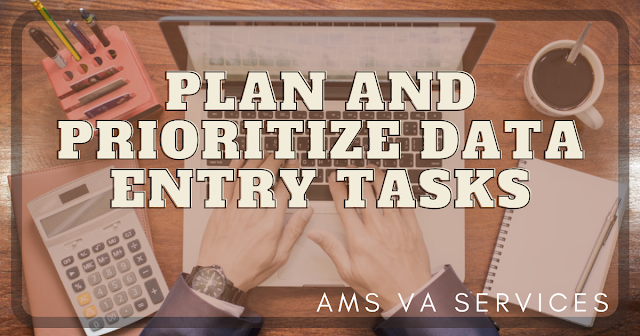Data entry is a critical task for many businesses, and it can be time-consuming and tedious. With the sheer amount of data being generated every day, it's essential to streamline the process and maximize productivity. One of the best ways to do this is by planning and prioritizing data entry tasks. In this article, we'll explore why planning and prioritizing data entry tasks is crucial, and we'll share some tips on how to do it effectively.
Why Plan and Prioritize Data Entry Tasks?
Data entry tasks can be overwhelming, especially when dealing with large volumes of data. It can be challenging to know where to start, what tasks to tackle first, and how to ensure that nothing gets missed. This is where planning and prioritizing come in. When you plan and prioritize your data entry tasks, you can:
Work efficiently:
By breaking down the data entry process into manageable parts and tackling them one at a time, you can work efficiently and effectively. This approach can help you avoid feeling overwhelmed and make it easier to focus on the task at hand.
Improve accuracy:
When you're under pressure to complete data entry tasks quickly, it's easy to make mistakes. By planning and prioritizing your tasks, you can take the time to review the data and ensure that everything is accurate.
Save time:
Planning and prioritizing your data entry tasks can help you save time in the long run. By focusing on the most critical tasks first, you can ensure that nothing gets missed, and you can avoid having to redo work.
How to Plan and Prioritize Data Entry Tasks
Here are some tips for planning and prioritizing your data entry tasks effectively:
Break Down the Process
The first step in planning and prioritizing data entry tasks is to break down the process into manageable parts. Start by identifying all the tasks that need to be completed and breaking them down into smaller steps. This will help you get a better idea of the scope of the work and the time required to complete each task.
Prioritize Tasks
Once you've broken down the data entry process, the next step is to prioritize tasks. Identify the most critical tasks and focus on completing them first. This might include tasks that have tight deadlines or those that require more time and attention to detail.
Set Realistic Deadlines
Setting realistic deadlines is essential when planning and prioritizing data entry tasks. Be realistic about how long each task will take and factor in any unexpected delays or interruptions. By setting achievable deadlines, you can avoid feeling overwhelmed and ensure that you can complete the work on time.
Use a Task Management Tool
Task management tools can be helpful when planning and prioritizing data entry tasks. These tools can help you keep track of what needs to be done, who is responsible for each task, and when tasks are due. Some popular task management tools include Trello, Asana, and Monday.com.
Communicate with Your Team
If you're working as part of a team, it's essential to communicate with your team members about the data entry tasks. Make sure everyone is clear on what needs to be done, who is responsible for each task, and when tasks are due. This can help ensure that everyone is on the same page and can work together to complete the work efficiently.
Review and Revise Your Plan
Finally, it's essential to review and revise your plan regularly. As you work through the data entry tasks, you may discover that some tasks take longer than expected, or that there are unexpected delays. By reviewing and revising your plan regularly, you can adjust your priorities and deadlines as needed to ensure that the work is completed on time.
Conclusion
Planning and prioritizing data entry tasks can help businesses improve their efficiency, accuracy, and productivity. By breaking down
